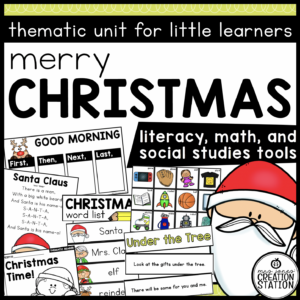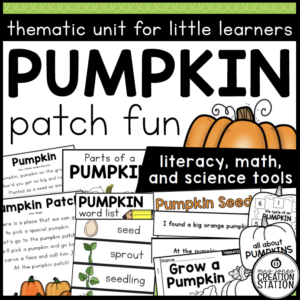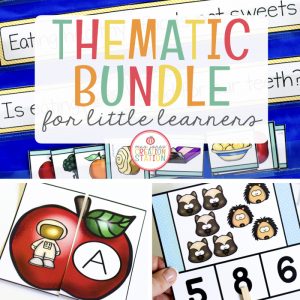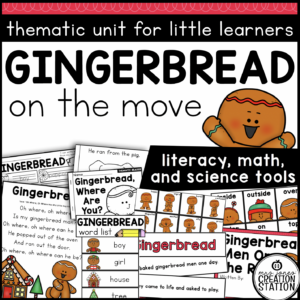NOCTURNAL ANIMALS UNIT FOR PRESCHOOL, PREK AND KINDERGARTEN
Get ready to see the dark in a whole new light as we dive into the fascinating world of nocturnal animals! This resource includes easy to follow lessons, activities that focus on the difference between nocturnal and dinural animals, literacy and match centers.
This unit does a great job of joining science and literacy together with shared reading, writing activities as well as my popular interactive poem.
The easy to follow thematic lesson plans provide a daily objective to learn more about nocturnal animals and their habitats. A list of fun picture books are included that are easy to find by just using one click!
Here is what you’ll get:
-Detailed lessons plans that are easy to read and follow
–Daily slides to guide your teaching
-A list of suggested read alouds with links
–Shared Reading and Writing activities
-Directed Drawings
-Emergent Readers
-Interactive Poems
-A week of thematic activities on nocturnal animals
-Math Centers
-Literarcy Centers
Buy the BUNDLE and SAVE! You can purchase this resources in the Thematic Activities for Little Learners Bundle and the Little Learners Mega-Bundle!
⭐⭐⭐⭐⭐ What Teachers Are Saying:
“I have been using Mrs. Jones’ Creation Station units for years in my kindergarten classes. They are beyond comprehensive. Now that I am homeschooling my grandson, I know he’ll love this nocturnal animals unit.“ –Wendy T.
“The kids enjoyed making the booklet about diurnal and nocturnal animals– though, it was a stretch for many of my littles! The graphics are cute and there are a lot of fun ideas.” –Lindsey H.
“I loved these themed units! I tried to buy every unity that aligns to my classroom themes. They are worth the money!” –Whitney H.
YOU MIGHT ALSO LIKE
Haunted Halloween Thematic Unit
Fall Thematic Unit
Scarecrow Thematic Unit
LEARNING STANDARDS INCLUDED IN THIS RESOURCE
Common Core Standards
Language Arts
CCSSL.K.1a
Print many upper- and lowercase letters.
CCSSL.K.4
Determine or clarify the meaning of unknown and multiple-meaning words and phrases based on kindergarten reading and content.
CCSSRF.K.1a
Follow words from left to right, top to bottom, and page by page.
CCSSRF.K.1c
Understand that words are separated by spaces in print.
CCSSRF.K.1d
Recognize and name all upper- and lowercase letters of the alphabet.
CCSSRF.K.2a
Recognize and produce rhyming words.
CCSSRF.K.3
Know and apply grade-level phonics and word analysis skills in decoding words.
CCSSRF.K.3c
Read common high-frequency words by sight (e.g., the, of, to, you, she, my, is, are, do, does).
CCSSRI.K.3
With prompting and support, describe the connection between two individuals, events, ideas, or pieces of information in a text.
CCSSRI.K.4
With prompting and support, ask and answer questions about unknown words in a text.
CCSSSL.K.2
Confirm understanding of a text read aloud or information presented orally or through other media by asking and answering questions about key details and requesting clarification if something is not understood.
CCSSSL.K.3
Ask and answer questions in order to seek help, get information, or clarify something that is not understood.
CCSSSL.K.5
Add drawings or other visual displays to descriptions as desired to provide additional detail.
CCSSW.K.2
Use a combination of drawing, dictating, and writing to compose informative/explanatory texts in which they name what they are writing about and supply some information about the topic.
Math
CCSSK.CC.A.2
Count forward beginning from a given number within the known sequence (instead of having to begin at 1).
CCSSK.CC.A.3
Write numbers from 0 to 20. Represent a number of objects with a written numeral 0-20 (with 0 representing a count of no objects).
CCSSK.CC.B.4
Understand the relationship between numbers and quantities; connect counting to cardinality.
CCSSK.CC.B.4b
Understand that the last number name said tells the number of objects counted. The number of objects is the same regardless of their arrangement or the order in which they were counted.
CCSSK.CC.B.5
Count to answer “how many?” questions about as many as 20 things arranged in a line, a rectangular array, or a circle, or as many as 10 things in a scattered configuration; given a number from 1-20, count out that many objects.
CCSSK.G.A.2
Correctly name shapes regardless of their orientations or overall size.
Next Generation Science Standards
NGSSK-ESS3-1
Use a model to represent the relationship between the needs of different plants or animals (including humans) and the places they live. Examples of relationships could include that deer eat buds and leaves, therefore, they usually live in forested areas; and, grasses need sunlight so they often grow in meadows. Plants, animals, and their surroundings make up a system.
NGSSK-LS1-1
Use observations to describe patterns of what plants and animals (including humans) need to survive. Examples of patterns could include that animals need to take in food but plants do not; the different kinds of food needed by different types of animals; the requirement of plants to have light; and, that all living things need water.
Texas Essential of Knowledge and Skills
Language Arts
TEKSLA.K.2.B.iv
Developing and sustaining foundational language skills: listening, speaking, reading, writing, and thinking–beginning reading and writing… The student expects to: demonstrate and apply phonetic knowledge by: identifying and reading at least 25 high-frequency words from a research-based list.
TEKSLA.K.2.C.ii
Developing and sustaining foundational language skills: listening, speaking, reading, writing, and thinking–beginning reading and writing… The student expects to: demonstrate and apply spelling knowledge by: spelling words using sound-spelling patterns.
TEKSLA.K.2.C.iii
Developing and sustaining foundational language skills: listening, speaking, reading, writing, and thinking–beginning reading and writing…The student expects to: demonstrate and apply spelling knowledge by: spelling high-frequency words from a research-based list.
TEKSLA.K.2.D.iii
Developing and sustaining foundational language skills: listening, speaking, reading, writing, and thinking–beginning reading and writing…The student expects to: demonstrate print awareness by: recognizing that sentences are comprised of words separated by spaces and recognizing word boundaries.
TEKSLA.K.2.D.v
Developing and sustaining foundational language skills: listening, speaking, reading, writing, and thinking–beginning reading and writing…The student expects to: demonstrate print awareness by: identifying all uppercase and lowercase letters.
TEKSLA.K.5.B
Comprehension skills: listening, speaking, reading, writing, and thinking using multiple texts…The student expects to: generate questions about text before, during, and after reading to deepen understanding and gain information with adult assistance.
TEKSLA.K.5.F
Comprehension skills: listening, speaking, reading, writing, and thinking using multiple texts… The student expects to: make inferences and use evidence to support understanding with adult assistance.
TEKSLA.K.5.I
Comprehension skills: listening, speaking, reading, writing, and thinking using multiple texts…The student expects to: monitor comprehension and make adjustments such as re-reading, using background knowledge, checking for visual cues, and asking questions when understanding breaks down with adult assistance.
TEKSLA.K.6.B
Response skills: listening, speaking, reading, writing, and thinking using multiple texts. The student responds to an increasingly challenging variety of sources that are read, heard, or viewed. The student expects to: provide an oral, pictorial, or written response to a text.
TEKSLA.K.6.F
Response skills: listening, speaking, reading, writing, and thinking using multiple texts. The student responds to an increasingly challenging variety of sources that are read, heard, or viewed. The student expects to: respond using newly acquired vocabulary as appropriate.
TEKSLA.K.8.D.i
Multiple genres: listening, speaking, reading, writing, and thinking using multiple texts–genres…The student expects to: recognize characteristics and structures of informational text, including: the central idea and supporting evidence with adult assistance.
Math
TEKSMA.K.2.A
Number and operations. The student applies mathematical process standards to understand how to represent and compare whole numbers, the relative position and magnitude of whole numbers, and relationships within the numeration system. The student expects to: count forward and backward to at least 20 with and without objects.
TEKSMA.K.2.B
Number and operations. The student applies mathematical process standards to understand how to represent and compare whole numbers, the relative position and magnitude of whole numbers, and relationships within the numeration system. The student expects to: read, write, and represent whole numbers from 0 to at least 20 with and without objects or pictures.
TEKSMA.K.2.C
Number and operations. The student applies mathematical process standards to understand how to represent and compare whole numbers, the relative position and magnitude of whole numbers, and relationships within the numeration system. The student expects to: count a set of objects up to at least 20 and demonstrate that the last number said tells the number of objects in the set regardless of their arrangement or order.
TEKSMA.K.6.A
Geometry and measurement. The student applies mathematical process standards to analyze attributes of two-dimensional shapes and three-dimensional solids to develop generalizations about their properties. The student expects to: identify two-dimensional shapes, including circles, triangles, rectangles, and squares as special rectangles.
Science
TEKSSCI.K.9.B
Organisms and environments. The student knows that plants and animals have basic needs and depend on the living and nonliving things around them for survival. The student expects to: examine evidence that living organisms have basic needs such as food, water, and shelter for animals and air, water, nutrients, sunlight, and space for plants.
CONNECT WITH MJCS
WEBSITE | FACEBOOK | INSTAGRAM | PINTEREST
SaveSave




